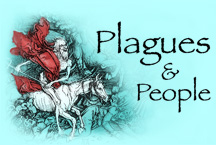
Infectious and Epidemic Disease in History
Department of History
University of California, Irvine
Instructor: Dr. Barbara J. Becker
excerpt from the writings of an anonymous author in Tlatelolco (1528) |

Department of History
University of California, Irvine
Instructor: Dr. Barbara J. Becker
excerpt from the writings of an anonymous author in Tlatelolco (1528) |
| The Captain [Hernando Cortes] marched back to the coast, leaving Don
Pedro de Alvarado -- The Sun -- in command.
During this time, the people asked Motecuhzoma how they should celebrate their god's fiesta. He said: "Dress him in all his finery, in all his sacred ornaments." During this same time, The Sun commanded that Motecuhzoma and Itzcohuatzin [eets-koh-WAH-tsin], the military chief of Tlatelolco [tlah-tel-OHL-koh], be made prisoners. The Spaniards hanged a chief from Acolhuacan [ah-kohl-wah-KAHN] named Nezahualquentzin [nay-sah-wahl-KEN-tsin]. They also murdered the king of Nauhtla [NAWH-tlah], Cohualpopocatzin [koh-wahl-poh-poh-CAH-tsin], by wounding him with arrows and then burning him alive. For this reason, our warriors were on guard at the Eagle Gate. The sentries from Tenochtitlan [tay-nahk-tee-TLAN; modern-day Mexico City] stood at one side of the gate, and the sentries from Tlatelolco at the other. But messengers came to tell them to dress the figure of Huitzilopochtli [whee-tsee-loh-POACH-tlee. They left their posts and went to dress him in his sacred finery: his ornaments and his paper clothing. When this had been done, the celebrants began to sing their songs. That is how they celebrated the first day of the fiesta. On the second day they began to sing again, but without warning they were all put to death. The dancers and singers were completely unarmed. They brought only their embroidered cloaks, their turquoises, their lip plugs, their necklaces, their clusters of heron feathers, their trinkets made of deer hooves. Those who played the drums, the old men, had brought their gourds of snuff and their timbrels. The Spaniards attacked the musicians first, slashing at their hands and faces until they had killed all of them. The singers -- and even the spectators -- were also killed. This slaughter in the Sacred Patio went on for three hours. Then the Spaniards burst into the rooms of the temple to kill the others: those who were carrying water, or bringing fodder for the horses, or grinding meal, or sweeping, or standing watch over this work. The king Motecuhzoma, who was accompanied by Itzcohuatzin and by those who had brought food for the Spaniards, protested: "Our lords, that is enough! What are you doing? These people are not carrying shields or macanas. Our lords, they are completely unarmed!" The Sun treacherously murdered our people on the twentieth day after the Captain left for the coast. We allowed the Captain to return to the city in peace. But on the following day we attacked him with all our might, and that was the beginning of the war. The Spaniards attempted to slip out of the city at night, but we attacked furiously at the Canal of the Toltecs, and many of them died. This took place during the fiesta of Tecuilhuitl [tay-keel-WHEE-tl]. The survivors gathered first at Mazatzintamalco [mah-sah-tsin-tah-MAHL-koh] and waited for the stragglers to come up. Year 2-Flint. This was the year in which Motecuhzoma died. Itzcohuatzin of Tlatelolco died at the same time. The Spaniards took refuge in Acueco [ah-KAY-co], but they were driven out by our warriors. They fled to Teuhcalhueyacan [tay-wh'-cahl-way-yah-KHAN] and from there to Zoltepec [sohl-TAY-pek]. Then they marched through Citlaltepec [see-tlahl-TAY-pek] and camped in Temazcalapan [tay-mahs-cah-lah-PAN], where the people gave them hens, eggs and corn.. They rested for a short while and marched on to Tlaxcala [tlah-SHKAH-la]. Soon after, an epidemic broke out in Tenochtitlan. Almost the whole population suffered from racking coughs and painful, burning sores. When the epidemic had subsided a little, the Spaniards marched out of Tlaxcala.... |
 |
| Go to: |
|
|